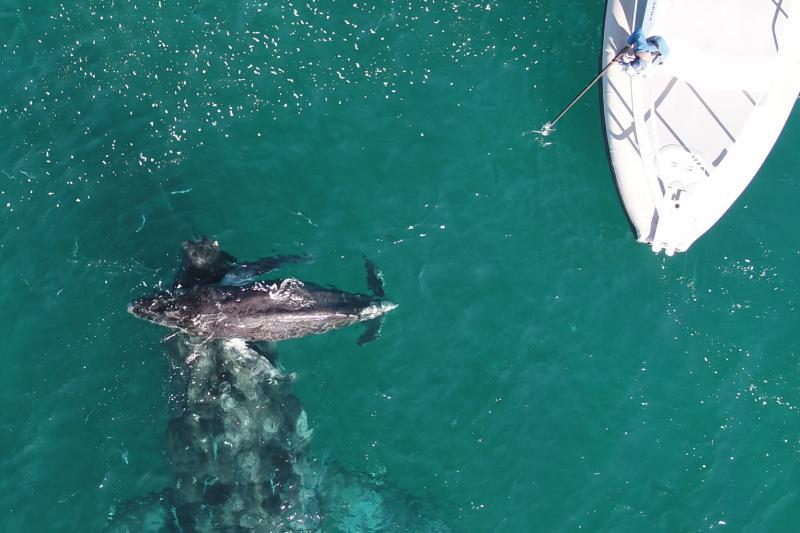
Deaths of young dolphin, Humpback calf highlight the importance of responsible boating
by NOAA Fisheries 17 Mar 2024 02:10 PDT

NOAA researchers with the Hawaiian Islands Humpback National Marine Sanctuary assess an injured humpback whale calf off of Maui. The calf had suspected vessel strike injuries to its tail © Pacific Whale Foundation (NOAA Fisheries Permit #24359)
In February 2024, NOAA Fisheries and partners responded to a dead spinner dolphin yearling and a dead humpback whale calf in Hawai'i. Examinations revealed their deaths were likely due to vessel strikes.
NOAA is urging boaters to slow down and enjoy marine wildlife from afar after the untimely passing of several young marine mammals in Hawai'i. Within the span of a few weeks in February, a Hawaiian spinner dolphin yearling and a humpback whale calf stranded dead in Hawai'i. Both of their injuries were consistent with vessel strike.
On February 12, 2024, NOAA Fisheries and the State of Hawai'i Department of Land and Natural Resources (DLNR) responded to a report of a dead Hawaiian spinner dolphin on the west side of Kaua'i. A necropsy (animal autopsy) conducted by the University of Hawai'i Health and Stranding Lab, our stranding network partner, determined the dolphin was a female, approximately 1 year old. The internal exam indicated the yearling died of trauma to the head consistent with a vessel strike.
The area where the dolphin was found was near a known resting area for Hawaiian spinner dolphins on the west side of Kaua'i. Spinner dolphins are nocturnal, feeding offshore at night and using nearshore habitat during the day to rest, socialize, and nurture their young. In 2021, NOAA published a final rule that prohibits swimming with, approaching, or remaining within 50 yards of Hawaiian spinner dolphins. The rule applies to any vessel, person, or object.
Just a few weeks later, on February 26, a humpback calf was found dead on the northeast side of Lana'i. NOAA Fisheries, DLNR's Division of Conservation and Resources Enforcement (DOCARE), and Pulama Lana'i responded. The University of Hawai'i Health and Stranding Lab conducted a necropsy. The internal exam indicated this calf also had multiple skull fractures consistent with vessel strike.
The area where the calf was found on Lana'i is within the Hawaiian Islands Humpback Whale National Marine Sanctuary. Every winter, thousands of humpback whales travel to the waters of Hawai'i to mate, give birth, and raise their young. The sanctuary was created to protect these whales and their habitat. Federal regulations prohibit approaching humpback whales in Hawai'i within 100 yards, both within the sanctuary and anywhere in the waters around Hawai'i out to 200 nautical miles.
So far in 2024, we have received six confirmed reports of vessel strikes to humpback whales in Hawai'i. One of the most recent reports involved another humpback whale calf, this time off of Maui. On February 23, NOAA officials with Hawaiian Islands Humpback Whale National Marine Sanctuary and members of the Pacific Whale Foundation responded to a live humpback calf about 300 yards off Ma'alaea Bay. The calf had suspected vessel strike injuries to its tail, and no recent sightings have been reported.
"It's heartbreaking when we lose these animals, especially when they're so young," said Diana Kramer, regional stranding coordinator, NOAA Fisheries Pacific Islands Regional Office. "These whales and dolphins are part of what makes Hawai'i the place many of us love. To protect and preserve them, we have to practice wildlife-friendly boating behaviors."
How Can You Help?
Go Slow, Whales Below
Vessel operators should reduce speed in areas commonly used by marine mammals and turtles and to always post a lookout. The recommended speed for vessels transiting coastal waters during whale season (November through April) is 15 knots or less. Recommended speed is 6 knots or less when within 400 yards of a whale or when making a directed approach or subsequent departure to and from the animals.
These speed recommendations aim to minimize the risk of striking a whale. They were developed jointly by the Hawaiian Islands Humpback Whale National Marine Sanctuary, DLNR, Pacific Whale Foundation, and members of the Hawai'i on-water community.
Learn more about State of Hawai'i guidelines on boating with whales.
Keep a Safe Distance
Vessel collisions pose a danger to marine species—and can harm people, too. Federal regulations prohibit approaching humpback whales in Hawai'i within 100 yards. And under the Hawaiian spinner dolphin approach rule, it is illegal to approach spinner dolphins within 50 yards. The rule applies to any vessel, person, or object.
Report Injuries, Entanglements, and Deaths
If you see an injured, entangled, or dead marine mammal, keep a safe and legal distance. Call the statewide NOAA Marine Wildlife Hotline at (888) 256-9840 or the U.S. Coast Guard on VHF channel 16 as soon as possible. While an entanglement may not impact an animal immediately, it can result in starvation, physical trauma, and infections. Entanglements may also contribute to vessel strikes since the animals are less mobile. Quick reporting is invaluable to our trained responders.
Learn more about reporting stranded or injured marine animals.
Report Potential Violations
You can report a vessel strike, or potential violations, several ways:
- Call the NOAA Fisheries Enforcement Hotline at (800) 853-1964
- Email respectwildlife@noaa.gov (for non-emergencies)
- Contact Hawai'i Department of Land and Natural Resources at (808) 643-DLNR or via the DLNRTip app